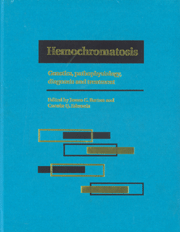Book contents
- Frontmatter
- Contents
- List of contributors
- Foreword
- Part I Introduction to hemochromatosis
- Part II Genetics of hemochromatosis
- Part III Metal absorption and metabolism in hemochromatosis
- Part IV Diagnostic techniques for iron overload
- Part V Complications of iron overload
- Part VI Therapy of hemochromatosis and iron overload
- Part VII Infections and immunity in hemochromatosis
- Part VIII Hemochromatosis heterozygotes
- Part IX Relationship of hemochromatosis to other disorders
- Part X Animal models of hemochromatosis and iron overload
- Part XI Screening for hemochromatosis
- Part XII Hemochromatosis: societal and ethical issues
- 52 Hemochromatosis: effect of iron fortification of foods
- 53 Evidence for population-based testing for hemochromatosis
- 54 Ethical issues and hemochromatosis
- 55 Hemochromatosis patients as blood and tissue donors
- 56 Genetic counseling for hemochromatosis
- Part XIII Final issues
- Index
56 - Genetic counseling for hemochromatosis
from Part XII - Hemochromatosis: societal and ethical issues
Published online by Cambridge University Press: 05 August 2011
- Frontmatter
- Contents
- List of contributors
- Foreword
- Part I Introduction to hemochromatosis
- Part II Genetics of hemochromatosis
- Part III Metal absorption and metabolism in hemochromatosis
- Part IV Diagnostic techniques for iron overload
- Part V Complications of iron overload
- Part VI Therapy of hemochromatosis and iron overload
- Part VII Infections and immunity in hemochromatosis
- Part VIII Hemochromatosis heterozygotes
- Part IX Relationship of hemochromatosis to other disorders
- Part X Animal models of hemochromatosis and iron overload
- Part XI Screening for hemochromatosis
- Part XII Hemochromatosis: societal and ethical issues
- 52 Hemochromatosis: effect of iron fortification of foods
- 53 Evidence for population-based testing for hemochromatosis
- 54 Ethical issues and hemochromatosis
- 55 Hemochromatosis patients as blood and tissue donors
- 56 Genetic counseling for hemochromatosis
- Part XIII Final issues
- Index
Summary
Introduction
Hemochromatosis often eludes diagnosis, although its early detection and treatment by phlebotomy can prevent complications of iron overload and premature death. Thus, screening persons over 20 years of age by measurement of serum iron concentration and transferrin saturation has been proposed. The recent cloning of a gene (HFE), mutations of which are found in 60–100% of Caucasian patients presenting with hemochromatosis, provides the opportunity for pre-symptomatic DNA-based genetic testing. Genetic counseling and education are strongly recommended as integral components of screening and genetic testing programs.
Genetic counseling has been defined as ‘the process by which patients or relatives at risk of a disorder that may be hereditary are advised of the consequences of the disorder, the probability of developing or transmitting it and of the ways in which this may be prevented, avoided or ameliorated’. This chapter provides the basis for counseling patients diagnosed with and those at risk of developing hemochromatosis. Although we rely on basic principles of genetic counseling, recommendations for the use of genetic testing for late-onset disorders will also be considered. Our recommendations will assist healthcare providers in educating and counseling patients with hemochromatosis and family members at risk. As knowledge of the genetic etiology of hemochromatosis and iron overload increases, and our ability to predict, treat, or cure hemochromatosis, these recommendations may change.
Identifying those at risk
When a person is diagnosed to have hemochromatosis, the healthcare provider's immediate concern is management of that person's illness. In addition, the provider must be aware that siblings, children, and other family members may also have this disorder.
- Type
- Chapter
- Information
- HemochromatosisGenetics, Pathophysiology, Diagnosis and Treatment, pp. 574 - 580Publisher: Cambridge University PressPrint publication year: 2000
- 2
- Cited by



